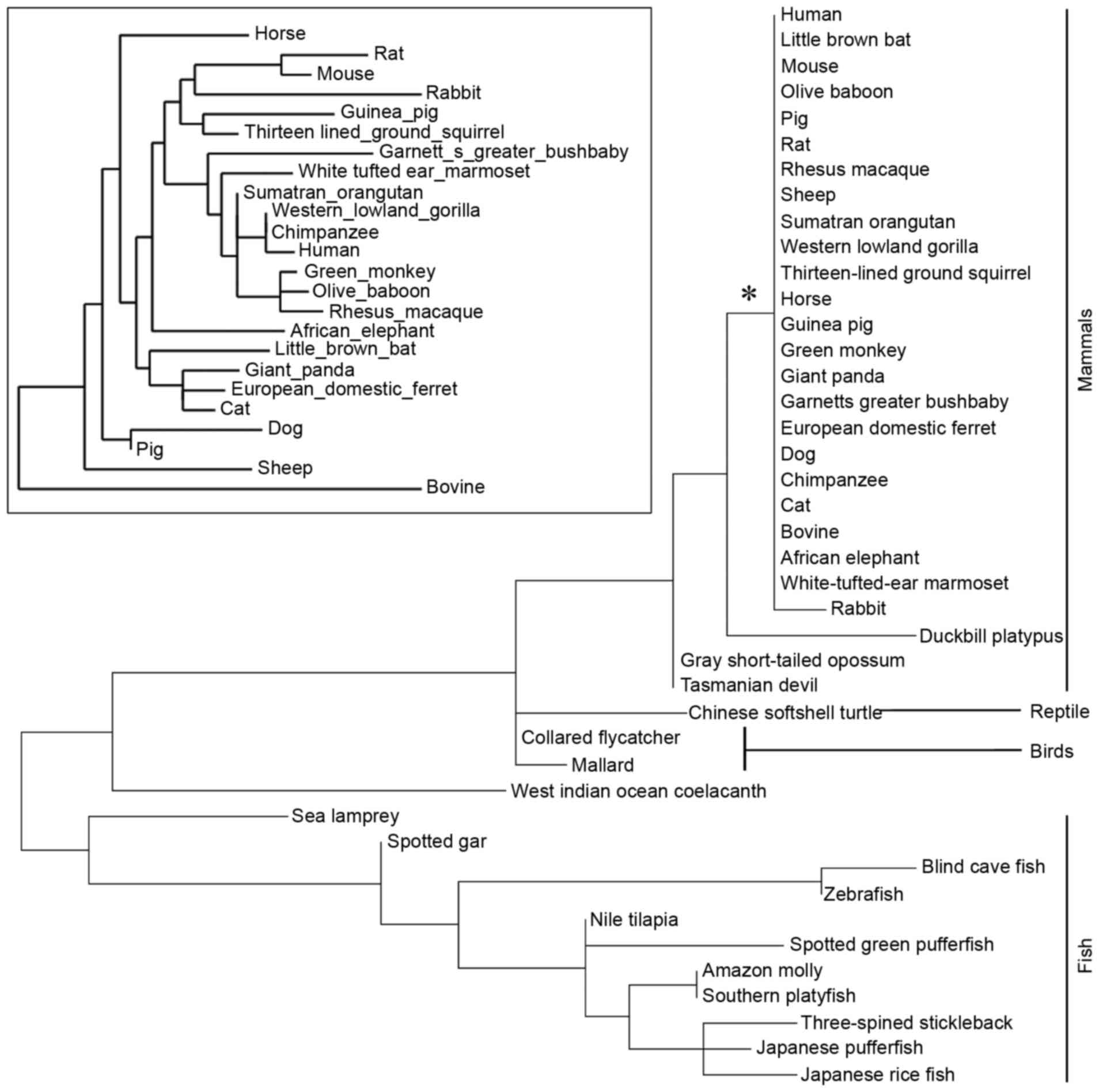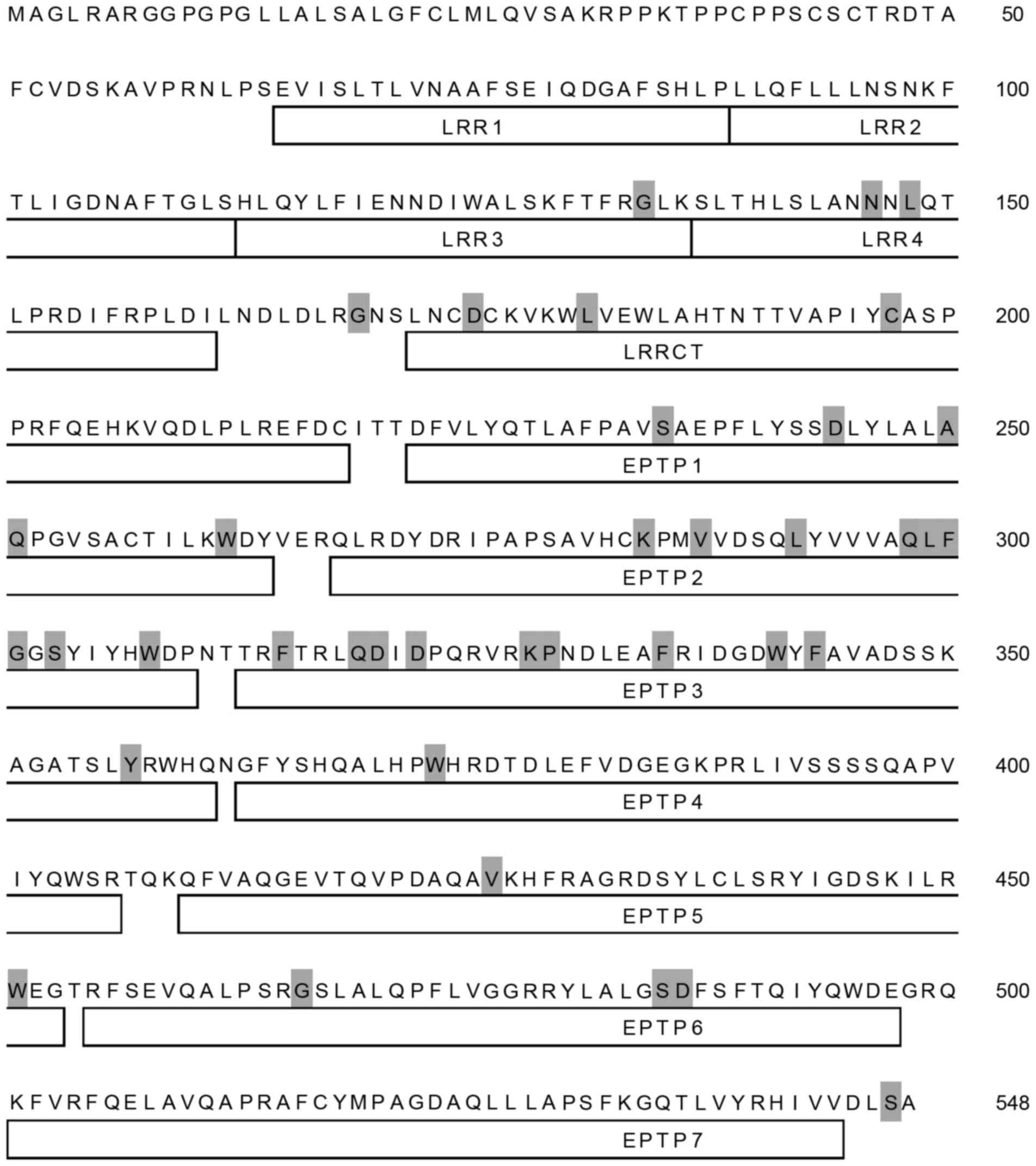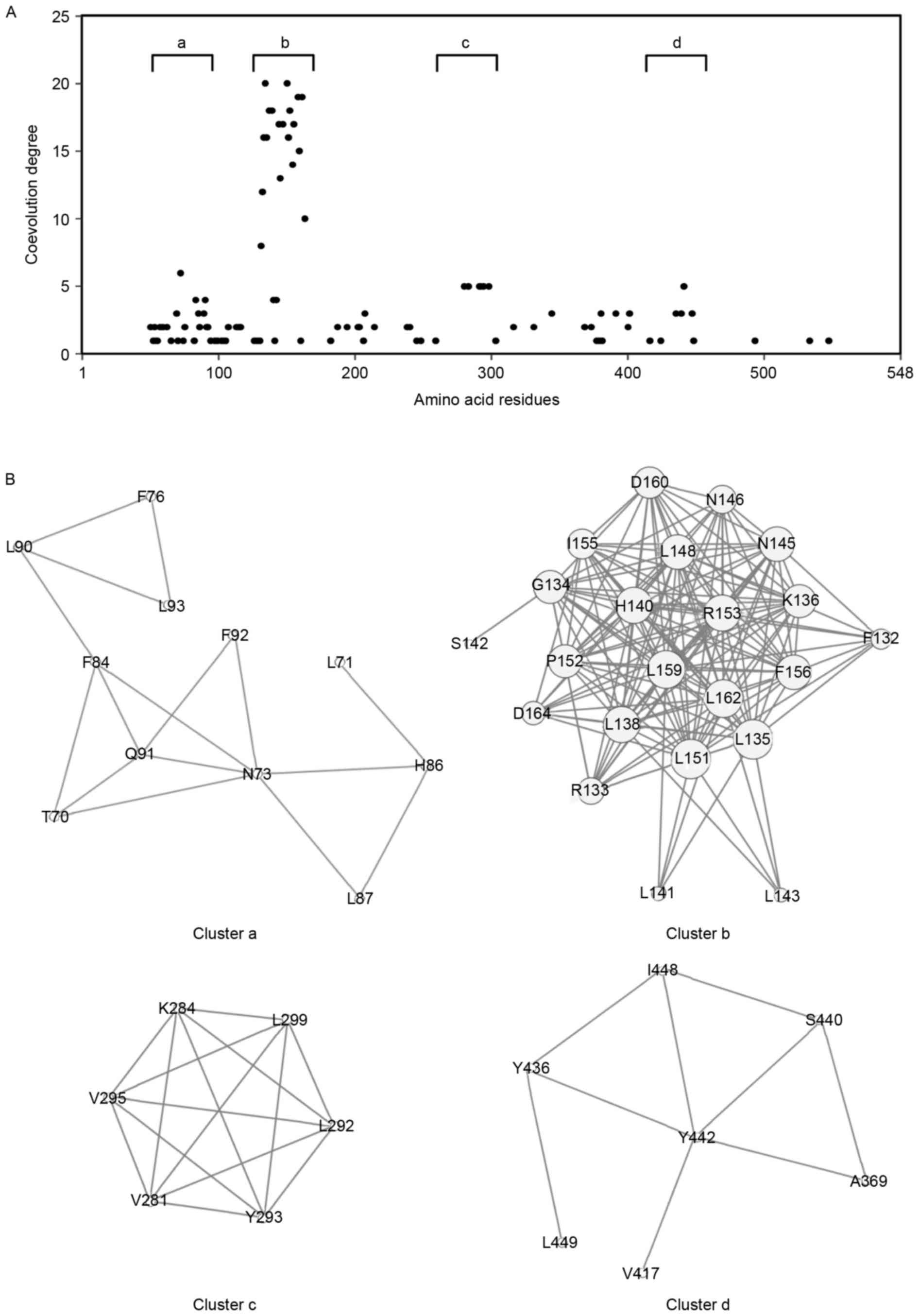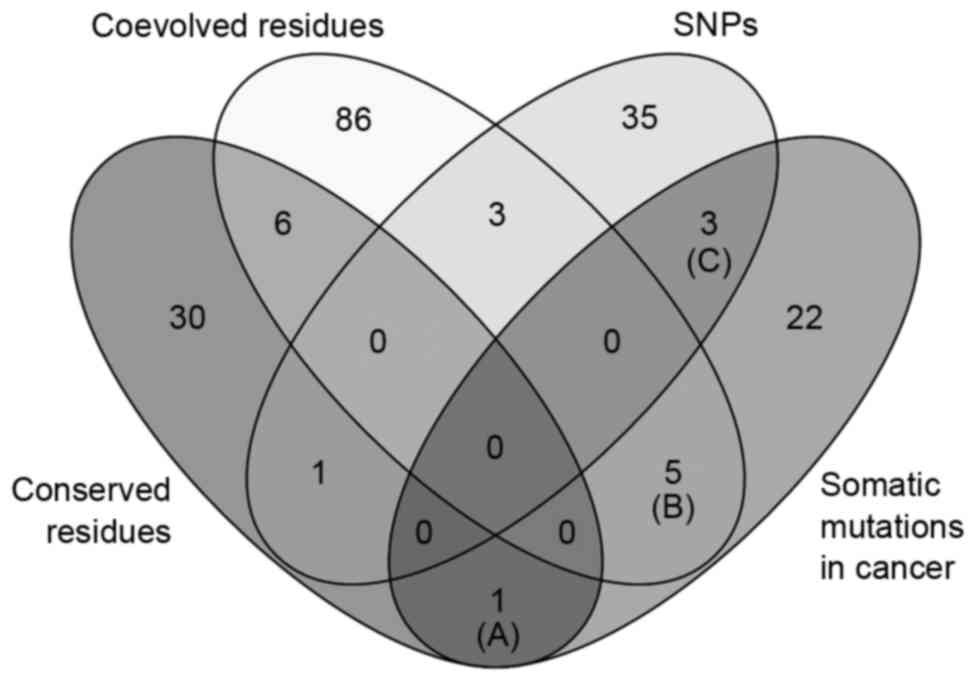Leucine-rich glioma inactivated 3: Integrative analyses reveal its potential prognostic role in cancer
- Authors:
- Published online on: December 14, 2017 https://doi.org/10.3892/mmr.2017.8279
- Pages: 3993-4002
Abstract
Introduction
Leucine-rich glioma inactivated 3 (LGI3) is a secreted protein member of the LGI family in vertebrates, which is expressed at high levels in the brain in a developmentally-regulated manner (1). The expression of LGI3 in the brain has been shown to be regulated at the transcriptional level by activating protein-2 and neuronal restrictive silencer (1). In our previous studies, it was reported that LGI3 regulated neuronal exocytosis and differentiation (2,3). In addition to the nervous system, LGI3 is expressed in various tissues, including adipose tissues and the skin (4,5). Our previous study demonstrated that the ultraviolet B-irradiation-induced secretion of LGI3 from human keratinocytes protected cells (5), and it was further shown that LGI3 promoted the migration of keratinocytes and melanogenic pigmentation (6,7).
Our previous studies also showed that the expression of LGI3 was downregulated during adipocyte differentiation and was upregulated in the adipose tissues of ob/ob mice and high fat diet-fed obese mice (4,8). It was shown that LGI3 attenuated adipogenesis through its receptor, a disintegrin and metalloproteinase domain-containing protein 23 (ADAM23), and that LGI3 increased the expression of inflammatory proteins, including tumor necrosis factor-α (TNF-α) in macrophages (4). LGI3 was shown to downregulate adiponectin, an anti-inflammatory adipokine (8). LGI3 and TNF-α were also found to be upregulated mutually through nuclear factor-κB (NF-κB), suggesting their importance in metabolic inflammation in obesity (9). Therefore, it was hypothesized that LGI3 is involved as a pro-inflammatory cytokine, which interacts with TNF-α and adiponectin, and these results supported the hypothesis that LGI3 is a multifunctional cytokine secreted by, and acting at, multiple cell types (3–9).
Cytokines, including TNF-α and adiponectin have been described as risk factors, and potential diagnostic and prognostic biomarkers in cancer (10,11). As LGI3 has been shown to interact with TNF-α and adiponectin in metabolic inflammation (8,9), it was hypothesized that LGI3 may also be associated with the cytokine network in cancer. To confirm this hypothesis, the present study analyzed the phylogeny of LGI3 orthologues, amino acid coevolution, single nucleotide polymorphisms (SNPs), somatic mutations and expression microarray data in different types of cancer. The results of these integrative analyses supported the potential significance of LGI3 in cancer prognosis.
Materials and methods
Sequence retrieval and phylogenetic analysis
All the LGI3 genes and amino acid sequences were obtained from the Ensembl database (http://www.ensembl.org). Comparative sequence analysis and alignment were performed using Blastp in NCBI (http://blast.ncbi.nlm.nih.gov/Blast.cgi?PAGE=Proteins) and ClustalW algorithm implemented in MEGA 6.0 software (http://www.megasoftware.net). A maximum likelihood tree of LGI3 was constructed using MEGA 6.0 with the Kimura 2 parameter model. Coevolution analysis of amino acid sequences was performed using Coevolution Analysis of Protein Sequences (CAPS 2.0; http://bioinf.gen.tcd.ie/caps) (12). The coevolved amino acid clusters were selected and diagrams were constructed using the Cytoscape 3.4.0 program (http://www.cytoscape.org).
SNP data evaluation
The SNPs of human LGI3 (GenBank accession no.: AAM49554.1) were extracted from the Ensembl (http://www.ensembl.org) and NCBI (http://www.ncbi.nlm.nih.gov) SNP databases. Functionally relevant SNPs, which disrupted reference amino acid sequence (missense, nonsense, frameshift and splice site variants) were selected for comparative analysis. SNPs with known global minor allele frequency (MAF) values were taken into account.
Somatic mutations in cancer
Somatic mutations of the human LGI3 gene in cancer were identified in Cbioportal (http://www.cbioportal.org) (13,14), the Catalogue of Somatic Mutations in Cancer (COSMIC; https://cancer.sanger.ac.uk/cosmic) and The Cancer Genome Atlas (TCGA; https://tcga-data.nci.nih.gov/tcga). A Venn diagram of the categorized genetic variations was generated using Venny 2.0.2 (http://bioinfogp.cnb.csic.es/tools/venny/index.html). The expression data of LGI3 in normal and cancer tissues were obtained from the Human Protein Atlas (http://www.proteinatlas.org) and NCBI UniGene (http://www.ncbi.nlm.nih.gov/unigene/).
Meta-analysis of expression microarray data
Gene expression microarray datasets were searched using the PrognoScan database (http://www.prognoscan.org) (15). This database consists of a large collection of publicly available cancer microarray datasets, providing sample name, raw expression data file, sample source name, array platform, and clinical annotations, including tumor grade diagnosis, histological diagnosis, age at diagnosis, survival time, treatment and therapy types. These datasets are previously subjected to quality control tests, normalization and batch effect adjustment, with exclusion of low-quality samples. The assessment of associations between gene expression and cancer prognosis use the minimum P-value approach for grouping patients for survival analysis, which identifies the optimal cutoff point in continuous gene expression measurement without prior assumption. Briefly, the patients ordered by the expression values were dichotomized at the cutoff point to minimize the P-value, and the survival difference between the high and low expression groups were calculated using the log-rank test. Kaplan-Meier plots of statistically significant (P<0.05; group size >10) datasets were generated.
Results
Phylogenetic analysis of LGI3 protein
As the LGI3 gene was initially identified in humans and mice (1,16), LGI3 gene orthologues were found only in vertebrates. The sequences of LGI3 gene products were retrieved from the Ensembl database and confirmed using BLASTp in the NCBI database. The complete LGI3 gene products were identified in 42 species, which belonged to vertebrates (phylum Chordata; subphylum Vertebrata). The phylogenetic tree was constructed according to the protein sequences of LGI3 (Fig. 1). The LGI3 protein from the Mammalia class (mammals) formed a highly conserved cluster (Fig. 1). A total of 38 amino acids residues of the LGI3 protein (548 amino acids) were identical in all species analyzed (Fig. 2). These conserved amino acids were distributed throughout all LGI3 protein domains, with the exception of the amino terminal region, including the first and second leucine-rich repeats (LRRs) and the carboxy terminal seventh epitempin (EPTP) domain.
Analysis of the phylogenetic tree of the LGI3 protein sequences may provide insight into the functionally important residues and their variants in diseases. Coevolution analysis was performed using the human LGI3 protein sequence as an input and 55 orthologues, including 42 full-length sequences, in CAPS software, which identifies coevolution between amino acid residues. The results showed that 100 amino acid residues were involved in coevolved amino acid pairs (Fig. 3A). The distribution of coevolution degrees revealed four clusters with a high coevolution degree: Cluster a, Thr70-Leu93; cluster b, Phe132-Asp164; cluster c, Val281-Leu299; and cluster d, Ala369-Leu449 (Fig. 3B). The amino acids in cluster b appeared to be highly coevolved, compared with those in the other clusters. Cluster b corresponded predominantly to the fourth LRR domain (LRR4; Fig. 2).
SNPs of the human LGI3 gene
A total of 1,042 SNPs were identified in the human LGI3 gene from the Ensembl and NCBI SNP databases. The SNPs which caused protein sequence variations were collected for comparative analysis. These included 217 missense SNPs, five nonsense SNPs and six frameshift SNPs. Of the 42 missense SNPs with known global MAF, four SNPs had a global MAF of ≥0.001 (Table I). These SNPs were distributed in the entire protein region, with the exception of the LRR2 domain (residues 88–113). These SNPs included a conserved residue (Gly466; Figs. 2 and 4) and three residues (Asn73, Gln204 and Tyr241) shown to be coevolved in the vertebrate phylogeny (Figs. 3 and 4).
Somatic mutations of LGI3 in cancer
The search for somatic mutations of the human LGI3 gene with amino acid alterations was performed using the Cbioportal, COSMIC and TCGA public databases. Mutations were found in various types of cancer, including uterine, stomach, lung, head and neck, skin, liver and bladder cancer (Table II). Venn diagram analysis of the amino acid variations in the four categories (conserved residues, coevolved residues, SNPs and somatic mutations in cancer) showed that a subgroup of somatic mutation sites in cancer belonged to conserved residues (one residue), coevolved residues (five residues) and SNPs (three residues), as shown in Fig. 4. The conserved residue (Gln319) was mutated in stomach cancer (Fig. 4; Table IIIA). The five coevolved amino acids were found to be mutated in liver, uterine, bladder, lung and thyroid cancer (Fig. 4; Table IIIB). The three SNP minor alleles were found in somatic mutations of stomach cancer and melanoma (Fig. 4; Table IIIC).
Prognostic significance of the expression of LGI3 in cancer
A previous study reported that LGI3 is expressed in various tumor cell lines (17). To examine the significance of the expression of LGI3 in the prognosis of cancer, the gene expression microarray datasets of cancer patient cohorts were analyzed. The results revealed an association between the expression level of LGI3 and cancer prognosis in brain cancer (astrocytoma), colorectal cancer and non-small cell lung cancer (Fig. 5A-C; Table IV). In these types of cancer cohorts (18–21), a lower expression of LGI3 was significantly correlated with poor patient survival rates (Fig. 5).
Table IV.Dataset description of somatic associations between expression microarray analyses of leucine-rich glioma inactivated 3 and cancer prognosis. |
Discussion
LGI3 is a member of the LGI protein family, which consists of four secreted proteins (LGI1, 2, 3 and 4) (1,22). Protein members of the LGI family are distinct in tissue distribution and physiological function (22,23). Our previous studies supported the roles of LGI3 as a cytokine in adipose tissues and the skin (4–9). The founding member of the LGI family, LGI1, was shown to be deficient in malignant gliomas due to gene rearrangements and was suggested to be a tumor suppressor gene (24). LGI protein members have been shown to be differentially expressed in various tumor cell types, including glioma, neuroblastoma, melanoma, colon cancer and breast cancer (17). These results indicated genetic alterations of these genes during tumorigenesis. To examine the association between LGI3 and cancer, the present study performed integrative analyses using phylogenetic and coevolution analyses, combined with the analyses of genomic variations and expression array data.
The phylogenetic tree of the LGI3 protein was restricted to vertebrates and formed the class-specific clusters of mammals, bird, reptiles and fish (Fig. 1). In particular, the highly conserved mammalian cluster of LGI3 sequences supports the validity of mammalian model systems in investigations of associations between cancer and LGI3 sequence variations. Conserved amino acid residues were relatively frequent in the EPTP2 and EPTP3 domains, suggesting their structural and functional importance (Fig. 2). Coevolution analysis revealed clusters with a high degree of coevolution of amino acid residues (Fig. 3). These conserved or coevolved residues may serve as crucial amino acids for the biologically active, native protein structure. Conserved residues are often found in global hinges in proteins, whereas coevolution propensity is associated with substrate or ligand recognition sites (25). Although the structure and ligand interactions of LGI3 protein remain to be fully elucidated, genetic variations of the conserved and coevolved residues are predicted to perturb its normal structure and function. Of 42 functionally relevant SNPs with a known global MAF (Table I), one SNP residue (Gly466) at a conserved residue and three SNPs (Asn73, Gln204 and Tyr241) at coevolved residues were predicted to affect the structure and function of LGI3.
The comparative analysis of somatic mutations in cancer, amino acid sequence variations and coevolution revealed eight somatic mutations, which occurred at coevolved or polymorphic residues (Fig. 4). These variants were found in various types of cancer (Table IIIB and C). All somatic mutations at coevolved amino acids located in LRR domains, which are predicted to be involved in protein-protein interactions for homo- or heterodimerization (22,26). As coevolved amino acids have been implicated in intramolecular interactions and protein network formation (12,27), functional investigations on variations of these amino acids may provide insight into the involvement of LGI3 in tumorigenesis. All SNPs with somatic mutations in stomach cancer and melanoma were rare variants (global MAF <0.001). Rare SNPs are often associated with cancer predisposition (28,29).
The expression of LGI3 is widespread in various tissues, including the brain, lung, skin, adipose tissues, heart, placenta, liver, muscle, kidney and pancreas (1,4,5,16). Predominant expression and its functional elucidation has been reported in the brain, adipose tissue and skin (3–5,9). A previous report showed that LGI3 was expressed in glioma, neuroblastoma, melanoma, colon cancer and breast cancer cells (17). Among four LGI family members, LGI3 was the only member expressed significantly in gliomas, melanomas and neuroblastoma (17). The present study found that the expression of LGI3 was associated with the prognosis of brain, colorectal and lung cancer (Fig. 5). The expression levels of LGI3 in these types of cancer were positively correlated with survival rates. This suggested that LGI3 may function as a suppressor of tumor progression. Somatic mutations and associations between expression and prognosis were found in lung cancer (Tables IIIB and IV). LGI3 was shown to transduce signals in its target cells through proteins implicated in cancer, including ADAM23, Akt, β-catenin, focal adhesion kinase, MDM2, p53, NF-κB and microphthalmia-associated transcription factor (3,5,6,9,30–33). Perturbation of these proteins by somatic mutations and the altered expression of LGI3 may account for its role in the pathogenesis and prognosis of cancer. These results warrant further investigations on the correlation between LGI3 sequence variations, and the expression and multiple clinical parameters of cancer.
Cytokine networks have important regulatory roles in cancer and numerous cytokines are involved in inflammatory immune responses to tumors (11,34). Cytokines are important in chronic inflammation, which may lead to carcinogenesis (34). Obesity increases cancer risk through cytokine perturbations by metabolic inflammation, particularly in the liver, pancreas and gastrointestinal tract (35). TNF-α and adiponectin have been shown to be regulated by LGI3 in adipose tissues in obesity (8,9) and associated with various types of cancer (10,11). Diet-induced obesity has also been shown to elevate TNF-α and local inflammation, which may promote colorectal cancer and hepatocellular carcinoma (36). Adiponectin has been shown to be inversely correlated with the risk of endometrial, breast, colon, renal, gastric and prostate cancer (10). In conclusion, LGI3 may be involved in the cytokine network involved in various types of cancer and have a potential role in cancer prognosis.
Acknowledgements
This study was supported by the Basic Science Research Program through the National Research Foundation of Korea funded by the Ministry of Education (grant no. NRF-2015R1D1A1A01056981).
References
|
Lee SE, Lee AY, Park WJ, Jun DH, Kwon NS, Baek KJ, Kim YG and Yun HY: Mouse LGI3 gene: Expression in brain and promoter analysis. Gene. 372:8–17. 2006. View Article : Google Scholar : PubMed/NCBI | |
|
Park WJ, Lee SE, Kwon NS, Baek KJ, Kim DS and Yun HY: Leucine-rich glioma inactivated 3 associates with syntaxin 1. Neurosci Lett. 444:240–244. 2008. View Article : Google Scholar : PubMed/NCBI | |
|
Park WJ, Lim YY, Kwon NS, Baek KJ, Kim DS and Yun HY: Leucine-rich glioma inactivated 3 induces neurite outgrowth through Akt and focal adhesion kinase. Neurochem Res. 35:789–796. 2010. View Article : Google Scholar : PubMed/NCBI | |
|
Kim HA, Park WJ, Jeong HS, Lee HE, Lee SH, Kwon NS, Baek KJ, Kim DS and Yun HY: Leucine-rich glioma inactivated 3 regulates adipogenesis through ADAM23. Biochim Biophys Acta. 1821:914–922. 2012. View Article : Google Scholar : PubMed/NCBI | |
|
Lee SH, Jeong YM, Kim SY, Jeong HS, Park KC, Baek KJ, Kwon NS, Yun HY and Kim DS: Ultraviolet B-induced LGI3 secretion protects human keratinocytes. Exp Dermatol. 21:716–718. 2012. View Article : Google Scholar : PubMed/NCBI | |
|
Jeong HS, Jeong YM, Kim J, Lee SH, Choi HR, Park KC, Kim BJ, Baek KJ, Kwon NS, Yun HY and Kim DS: Leucine-rich glioma inactivated 3 is a melanogenic cytokine in human skin. Exp Dermatol. 23:600–602. 2014. View Article : Google Scholar : PubMed/NCBI | |
|
Jeong YM, Park WJ, Kim MK, Baek KJ, Kwon NS, Yun HY and Kim DS: Leucine-rich glioma inactivated 3 promotes HaCaT keratinocyte migration. Wound Repair Regen. 21:634–640. 2013. View Article : Google Scholar : PubMed/NCBI | |
|
Kim HA, Kwon NS, Baek KJ, Kim DS and Yun HY: Leucine-rich glioma inactivated 3 associates negatively with adiponectin. Cytokine. 62:206–209. 2013. View Article : Google Scholar : PubMed/NCBI | |
|
Kim HA, Kwon NS, Baek KJ, Kim DS and Yun HY: Leucine-rich glioma inactivated 3 and tumor necrosis factor-α regulate mutually through NF-κB. Cytokine. 72:220–223. 2015. View Article : Google Scholar : PubMed/NCBI | |
|
Dalamaga M, Diakopoulos KN and Mantzoros CS: The role of adiponectin in cancer: A review of current evidence. Endocr Rev. 33:547–594. 2012. View Article : Google Scholar : PubMed/NCBI | |
|
Lippitz BE: Cytokine patterns in patients with cancer: A systematic review. Lancet Oncol. 14:e218–e228. 2013. View Article : Google Scholar : PubMed/NCBI | |
|
Fares MA and McNally D: CAPS: Coevolution analysis using protein sequences. Bioinformatics. 22:2821–2822. 2006. View Article : Google Scholar : PubMed/NCBI | |
|
Cerami E, Gao J, Dogrusoz U, Gross BE, Sumer SO, Aksoy BA, Jacobsen A, Byrne CJ, Heuer ML, Larsson E, et al: The cBio cancer genomics portal: An open platform for exploring multidimensional cancer genomics data. Cancer Discov. 2:401–404. 2012. View Article : Google Scholar : PubMed/NCBI | |
|
Gao J, Aksoy BA, Dogrusoz U, Dresdner G, Gross B, Sumer SO, Sun Y, Jacobsen A, Sinha R, Larsson E, et al: Integrative analysis of complex cancer genomics and clinical profiles using the cBioPortal. Sci Signal. 6:Pl12013. View Article : Google Scholar : PubMed/NCBI | |
|
Mizuno H, Kitada K, Nakai K and Sarai A: PrognoScan: A new database for meta-analysis of the prognostic value of genes. BMC Med Genomics. 2:182009. View Article : Google Scholar : PubMed/NCBI | |
|
Gu W, Wevers A, Schröder H, Grzeschik KH, Derst C, Brodtkorb E, de Vos R and Steinlein OK: The LGI1 gene involved in lateral temporal lobe epilepsy belongs to a new subfamily of leucine-rich repeat proteins. FEBS Lett. 519:71–76. 2002. View Article : Google Scholar : PubMed/NCBI | |
|
Rossi MR, Huntoon K and Cowell JK: Differential expression of the LGI and SLIT families of genes in human cancer cells. Gene. 356:85–90. 2005. View Article : Google Scholar : PubMed/NCBI | |
|
Phillips HS, Kharbanda S, Chen R, Forrest WF, Soriano RH, Wu TD, Misra A, Nigro JM, Colman H, Soroceanu L, et al: Molecular subclasses of high-grade glioma predict prognosis, delineate a pattern of disease progression, and resemble stages in neurogenesis. Cancer Cell. 9:157–173. 2006. View Article : Google Scholar : PubMed/NCBI | |
|
Smith JJ, Deane NG, Wu F, Merchant NB, Zhang B, Jiang A, Lu P, Johnson JC, Schmidt C, Bailey CE, et al: Experimentally derived metastasis gene expression profile predicts recurrence and death in patients with colon cancer. Gastroenterology. 138:958–968. 2010. View Article : Google Scholar : PubMed/NCBI | |
|
Bild AH, Yao G, Chang JT, Wang Q, Potti A, Chasse D, Joshi MB, Harpole D, Lancaster JM, Berchuck A, et al: Oncogenic pathway signatures in human cancers as a guide to targeted therapies. Nature. 439:353–357. 2006. View Article : Google Scholar : PubMed/NCBI | |
|
Wilkerson MD, Yin X, Hoadley KA, Liu Y, Hayward MC, Cabanski CR, Muldrew K, Miller CR, Randell SH, Socinski MA, et al: Lung squamous cell carcinoma mRNA expression subtypes are reproducible, clinically important, and correspond to normal cell types. Clin Cancer Res. 16:4864–4875. 2010. View Article : Google Scholar : PubMed/NCBI | |
|
Kegel L, Aunin E, Meijer D and Bermingham JR: LGI proteins in the nervous system. ASN Neuro. 5:167–181. 2013. View Article : Google Scholar : PubMed/NCBI | |
|
Kegel L, Jaegle M, Driegen S, Aunin E, Leslie K, Fukata Y, Watanabe M, Fukata M and Meijer D: Functional phylogenetic analysis of LGI proteins identifies an interaction motif crucial for myelination. Development. 141:1749–1756. 2014. View Article : Google Scholar : PubMed/NCBI | |
|
Chernova OB, Somerville RP and Cowell JK: A novel gene, LGI1, from 10q24 is rearranged and downregulated in malignant brain tumors. Oncogene. 17:2873–2881. 1998. View Article : Google Scholar : PubMed/NCBI | |
|
Liu Y and Bahar I: Sequence evolution correlates with structural dynamics. Mol Biol Evol. 29:2253–2263. 2012. View Article : Google Scholar : PubMed/NCBI | |
|
Kobe B and Deisenhofer J: A structural basis of the interactions between leucine-rich repeats and protein ligands. Nature. 374:183–186. 1995. View Article : Google Scholar : PubMed/NCBI | |
|
Tillier ER and Charlebois RL: The human protein coevolution network. Genome Res. 19:1861–1871. 2009. View Article : Google Scholar : PubMed/NCBI | |
|
Grin B, Loeb S, Roehl K, Cooper PR, Catalona WJ and Helfand BT: A rare 8q24 single nucleotide polymorphism (SNP) predisposes North American men to prostate cancer and possibly more aggressive disease. BJU Int. 115:101–105. 2015. View Article : Google Scholar : PubMed/NCBI | |
|
Wu Q, Lu S, Wang L, Hu J, Qiao F, Qiu X, Zhao C, Lao Y, Song Y and Fan H: DNMT3A rs36012910 A>G polymorphism and gastric cancer susceptibility in a Chinese population. Mol Biol Rep. 39:10949–10955. 2012. View Article : Google Scholar : PubMed/NCBI | |
|
Costa FF, Verbisck NV, Salim AC, Ierardi DF, Pires LC, Sasahara RM, Sogayar MC, Zanata SM, Mackay A, O'Hare M, et al: Epigenetic silencing of the adhesion molecule ADAM23 is highly frequent in breast tumors. Oncogene. 23:1481–1488. 2004. View Article : Google Scholar : PubMed/NCBI | |
|
Ji Z, Erin Chen Y, Kumar R, Taylor M, Jenny Njauw CN, Miao B, Frederick DT, Wargo JA, Flaherty KT, Jönsson G and Tsao H: MITF modulates therapeutic resistance through EGFR signaling. J Invest Dermatol. 135:1863–1872. 2015. View Article : Google Scholar : PubMed/NCBI | |
|
Sulzmaier FJ, Jean C and Schlaepfer DD: FAK in cancer: Mechanistic findings and clinical applications. Nat Rev Cancer. 14:598–610. 2014. View Article : Google Scholar : PubMed/NCBI | |
|
Uzdensky AB, Demyanenko SV and Bibov MY: Signal transduction in human cutaneous melanoma and target drugs. Curr Cancer Drug Targets. 13:843–866. 2013. View Article : Google Scholar : PubMed/NCBI | |
|
West NR, McCuaig S, Franchini F and Powrie F: Emerging cytokine networks in colorectal cancer. Nat Rev Immunol. 15:615–629. 2015. View Article : Google Scholar : PubMed/NCBI | |
|
Font-Burgada J, Sun B and Karin M: Obesity and cancer: The oil that feeds the flame. Cell Metab. 23:48–62. 2016. View Article : Google Scholar : PubMed/NCBI | |
|
Catalán V, Gómez-Ambrosi J, Rodríguez A and Frühbeck G: Adipose tissue immunity and cancer. Front Physiol. 4:2752013. View Article : Google Scholar : PubMed/NCBI |














